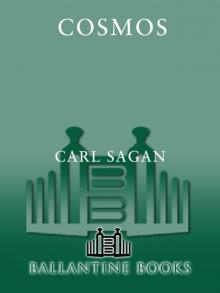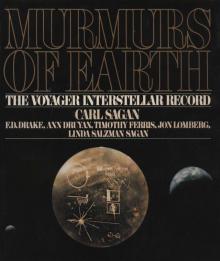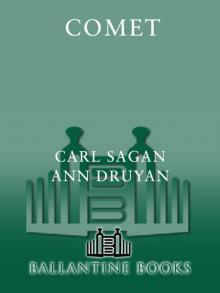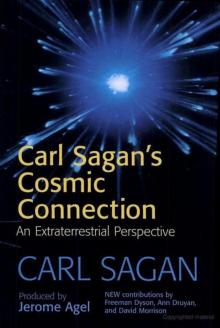- Home
- Carl Sagan
Comet Page 18
Comet Read online
Page 18
So let us ask a more modest question: Is there any historical record of the close approach to Earth of any sort of rotating, jetting cometary nucleus? In the case of Comet Morehouse 1908 III, the inner coma with its jets was about four thousand kilometers across, a more or less typical value, roughly the size of the Moon. If such a comet came as close to the Earth as the Moon is, the coma would of course appear to us just as large as the Moon, about half a degree across. On May 11, 1983, Comet IRAS-Araki-Alcock (named after a robot and two humans) passed within five million kilometers of our planet, a dozen times the Moon’s distance from the Earth. From the observed frequency with which new comets arrive in the inner solar system, it’s possible to calculate how long we have to wait before a comet comes as close as the Moon. The answer is a few thousand years at most. If you’re prepared to wait four or five thousand years, a cometary nucleus should pass you by at considerably closer range. Imagine the sky dominated by a dull, red irregular object, spitting out white canopies, its shimmering, curved fountains flowing into space, and all the material eventually swept back into a vast tail that extends from horizon to horizon. It would be a memorable event.
Except for an approach to the Earth from an unlikely sector of the sky, the comet would be seen by cultures all over the world. Surely, there would be a mythological framework—sometimes called a world view—into which this apparition would be fitted. People would naturally think the display held some portent or significance for them. Some cometary form should therefore have entered the art of many cultures, perhaps even in a central way. As time passed, the memory of the true events might fade, and the stories become vaguer, but the cometary form would still be a dominant motif in the art and records of the previous generations. If we saw such an apparition, and believed it was a message for us, we would not be disposed to ignore it. After thousands of years pass, the cometary symbol, whatever it was, might be wholly disconnected from its bizarre and awesome origins. In a prescientific, preliterate society, accounts of an unprecedented occurrence involving uncommon physics must necessarily, after thousands of years, take on lives of their own.
Halley’s Comet again in 1910 by Ricco. Courtesy National Aeronautics and Space Administration.
Because of extravagant claims made on meager evidence in a succession of popular books and articles over the centuries, the notion that historical catastrophes have been caused by collisions of comets with the Earth has become disreputable. But, at least from Halley’s time, it has been apparent that close approaches and even impacts of comets with the Earth will happen if only we wait long enough. As in all scientific questions, this one comes down to the quality of the evidence. We are aware of the need to proceed with caution.
The temptation to speculate on this matter is easily understood. If comets have come close in the last few generations, then over historical time, a really big comet must have ventured very near, with an appearance far more spectacular than anything in living memory. So you scurry around in the art and literature of myth, or in the geological record, until you find something that seems to you attributable to a comet. Then you write a book. Thus, Ignatius Donnelly—congressman, lieutenant governor of Minnesota, passionate advocate of human rights and the conservation of nature—proposed in 1883 in a wildly popular work called Ragnarok that the thick deposits of clay all over the world fell from the skies when the Earth passed through a comet built along the lines of the orbiting sand-bank model (Chapter 6). But clays are readily produced by known geological processes, and most show no sign in their atomic or molecular makeup of extraterrestrial origin. Also, the sand-bank model of comets is now known to be invalid, although it was the expert consensus in Donnelly’s time. Or, as another example, a Russian-American psychiatrist named Immanuel Velikovsky proposed that the plagues of Egypt, manna from heaven, and other snippets from ancient myth were generated by a comet that came too close to Earth. But a comet is hardly the only conceivable or the most probable explanation of such stories, and other elements of Velikovsky’s hypothesis are immersed deeply in error.
Yet there are reasons to think that accurate depictions of extraordinary as well as ordinary cometary events were, at least on occasion, made by the ancients. For example, the historian Ephorus, in the fourth century B.C., reported a comet that in 371 B.C. split into two. Subsequent writers continued to quote Ephorus, although with considerable skepticism. By the time of Seneca and Pliny, there were no other examples of fragmenting comets, and yet a record that a comet had once split in two was safely transmitted to our time. Today we know—as with Biela’s Comet and the sungrazers—that fragmentation does occur. Ephorus is vindicated, and we learn that unusual cometary happenings can accurately be passed down through the millennia.
Comet Arend-Roland (1957 III) on April 25, 1957. Photograph by H. Neckel. From N. B. Richter, The Nature of Comets (Methuen, 1963).
The Great Comet of 1861 drawn by Warren de la Rue, on July 2, 1861. From Amédée Guillemin’s World of Comets (Paris, 1877).
In our century, there have been extensive Newtonian calculations of the orbit of Halley’s Comet, with predictions—or, rather, postdictions—of the date and position of the comet in the sky for every apparition back to 240 B.C. For every one of these calculated apparitions, convincing evidence exists in ancient chronicles that a bright comet was indeed in the predicted part of the sky on the date in question. In addition to improving our already high confidence in Newtonian gravitational theory, this concordance between theory and observation renews our respect for the precision and attentiveness of ancient Chinese, Korean, Japanese, Babylonian, and European chroniclers. While this respect does not extend so far as to giving full credence to descriptions of comets encumbered with dragons, swords, or faces, it does suggest that in the historical depictions of the forms of comets there may be preserved for us something of the natural history of these idiosyncratic visitors from the depths of space.
Comet Tebbutt (1861 II) as drawn by Secchi. Courtesy National Aeronautics and Space Administration.
Pliny noted the appearance of a comet “too brilliant to be looked at directly; it was white with silver hair and resembled a god in human form.” What are we to make of this? For a comet to be so bright, it would have to be sheathed in a coma and pass close to Earth. Not impossible. The configuration of the coma can be complicated, and can suggest a human form. But a silver-haired comet god is certainly not widely dispersed in the myth and art of Earth.
Pliny described another kind of comet in these words: “Like a horse’s mane, it has a very rapid motion, like a circle revolving on itself.” The theme of rotation is occasionally connected with comets in the ancient records. Epigenes proposed that comets are born in whirlwinds, a view that Seneca dismisses for good reason, but a nearby rotating, jetting cometary nucleus might look very much like a whirlwind. Among Seneca’s objections are that whirlwinds have brief durations, and that their rotary motions would be dissipated by the speedy passage of the heavens around the Earth. Seneca did not know that the Earth turns. He says, “The shape of a whirlwind is round … therefore the fire which is enclosed [within the hypothetical cometary whirlwind] ought to be like a whirlwind. And yet the first is elongated and scattered and not at all like something round-shaped.” It might just be that Seneca and Epigenes are describing different aspects of comets—Seneca the coma and tail, and Epigenes, a close look at a rapidly rotating nucleus. (Before the invention of the telescope, the comet would have to come very close to the Earth for rotation to be apparent.) We therefore ask if there is some widespread ancient symbol, associated with the sky, that indicates rotation. Very tentatively, we suggest that there is one such symbol, the swastika.
This symbol of four bent arms emanating from a common center was officially adopted and made synonymous with horror by the Nazi regime in Germany. The Nazi crimes against humanity are well documented if insufficiently reflected upon; long after their passing, the Nazis are still poisoning amity among nations. But there was a time, l
ong before Nazis, when swastikas abounded, benign symbols known to almost every culture on the planet. If you can for a moment, try to ignore the association of the Nazis with this symbol, and consider it for itself.
In 1979, for our Cosmos television series, we were in India to film the celebration of the cycle of the seasons, called Pongal. We were deeply moved by the generosity and kindness of the Hindu villagers of Thanjavur, in Dravidian South India. We were a little taken aback, however, when, in chalk, they began cheerfully marking swastikas on their doorsteps. It was an ancient symbol of good fortune, they explained. Indeed it is.
In the two deepest and therefore oldest levels in Troy—dating back to 3000 B.C. in the Early Bronze Age—no signs of swastikas are found; but beginning with what he called the third or burnt city, dating back to the beginning of the second millennium B.C., Heinrich Schliemann, the discoverer of Troy, found them everywhere. Hundreds of recovered artifacts, especially spindles operated in rotary motion, were festooned with swastikas. In Tang Dynasty China, public misuse of this important symbol had reached such a state that an imperial decree had to be issued forbidding the imprinting of swastikas on silk fabrics. In the west of India there are caverns which serve as Buddhist shrines; most of the rock inscriptions are preceded or followed by a swastika. The Jains—a religious community in India which, in its respect for the sanctity of all life, stands at the opposite pole from the Nazis—use the swastika “as a sign of benediction and blessing,” for which reason also the Japanese once put it on their coffins. An account of Tibet in The Times of London in 1904 describes “a few white, straitened hovels in tiers … On the door of each is a kicking swastika in white, and over it a rude daub of ball and crescent,” astronomical symbols representing Sun and Moon. On blankets, beadwork, pottery, and other artifacts, the swastika was once a common, almost typical, symbol of the indigenous peoples of North America. Thomas Wilson, the curator of the Department of Prehistoric Anthropology at the U.S. National Museum, wrote in 1896:
Coggia’s Comet (1874 III), drawn by Chambers. Courtesy National Aeronautics and Space Administration.
We know not whether it is intended as a religious symbol, a charm of blessing or good luck, or whether it is only an ornament. We do not know whether it has any hidden, mysterious, or symbolic meaning; but there it is, a prehistoric or Oriental Swastika in all its purity and simplicity, appearing in one of the mystic ceremonies of the Aborigines in the great American desert in the interior of the North American continent.
How does the same curious symbol become established in the ancient cultures of India, China, the American Southwest, Mayan Mexico, Brazil, Britain, and Turkey, among others? The swastika was in general use in Bronze Age Europe from the Arctic to the Mediter-ranean, spreading, in the Iron Age, to the Etruscan, Mycenaen, Trojan and Hittite civilizations. The word itself is Sanskrit:
The root word, svasti, literally means well-being. The sign swastika must have existed long before the name was given to it. It must have been in existence long before the Buddhist religion or the Sanskrit language …
Looking over the entire prehistoric world, we find the swastika used on small and comparatively insignificant objects … such as vases, pots, drugs, implements, tools, household goods and utensils … and infrequently on statues, altars, and the like … [It was used] in Italy on the urns in which the ashes of the dead are buried; in the Swiss lakes stamped in the pottery; in Scandinavia on the weapons, swords, et cetera, and in Scotland and Ireland on the brooches and pins; in America on the metates for grinding corn; the Brazilian women wore it on the pottery fig leaf; the Pueblo Indian painted it on his dance rattle, while the North American Indian, at the epoch of the moundbuilding in Arkansas and Missouri, painted it in spiral form on his pottery; in Tennessee he engraved it on the shell, and in Ohio cut it in its plainest normal form out of sheets of copper … As we do not find it represented in America on aboriginal religious monuments, on ancient gods, idols, or other sacred or holy objects, we are justified in claiming that it was not here used as a religious symbol … With this preponderance in favor of the common use, it would seem that, except among the Buddhists and early Christians, and the more or less sacred ceremonies of the North American Indians, all pretense of the holy or sacred character of the swastika should be given up.
This is from Wilson’s classic work on the ethnography of the swastika. Wilson was skeptical of the idea that a swastika was passed from culture to culture by diffusion:
If the sign bore among the aborigines in America the name it bore in India, Swastika, the evidence of contact and communication would be greatly strengthened. If the religion it represented in India should be found in America, the chain of evidence might be considered complete.
Spindle, adorned with a swastika, one of hundreds found by Schliemann at Troy. From Thomas Wilson, The Swastika: The Earliest Known Symbol, and Its Migrations; With Observation on the Migration of Certain Industries in Prehistoric Times (Smithsonian Institution, Washington, D.C., 1896).
Swastika symbol on an Etruscan gold “bulla.” From Wilson.
Iron Age spear, recovered near Brandenburg, Germany, with symbols including a right-angled four-armed swastika (lower right) and an ogee three-armed swastika (top right). From Wilson.
But this is not the case. On the other hand, Wilson argues that the swastika is by no means so simple a design that it would have arisen spontaneously the world over:
For evidence of this, I cite the fact that it is not in common use, that it is almost unknown among Christian peoples, that it is not included in any of the designs for, nor mentioned in any of the modern European or American works on decoration, nor is it known to or practiced by artists or decorators of other countries …
The straight line, the circle, the cross, the triangle, are simple forms, easily made, and might have been invented and re-invented in every age of primitive man and in every quarter of the globe, each time being an independent invention, meaning much or little, meaning different things among different peoples or at different times among the same people; or they may have had no settled or definite meaning. But the Swastika was probably the first to be made with definite intention and a continuous or consecutive meaning, the knowledge of which passed from person to person …
This is a real puzzle: a symbol thousands of years old that neither arises spontaneously in the mind of the artist nor, primarily, passes from culture to culture. It baffled Schliemann too, who remarked, “The problem is insoluble.” And perhaps it is. However, if the swastika were originally something in the skies, something that could be witnessed independently by widely separated cultures, the mystery might be solved. The symbol then would arrive in each culture from outside, and yet not be transmitted from other cultures.
In the more ancient representations of the swastika, one often sees the arms curved, not bent; this is called the ogee swastika. In thinking about the significance of the swastikas he had discovered in ancient Troy, Schliemann thought he saw an attempt to depict spin, and suggested that the direction of motion was specified by the direction of the arms, which always trailed the rotation. But as to what it was that was rotating, he offered no hypothesis.
Pottery from ancient Samarra. The recovered shard, with figures shown in black, is used in an attempt to reconstruct the complete pattern. After Count Eugène Felicien Albert Goblet d’Alviella, The Migration of Symbols (Paris, 1891).
Another dilemma running through scholarly writings on the swastika is that, on the one hand, it appears to be connected with something brilliant in the sky, and on the other hand it is clearly something separate from the Sun. To give a flavor of the often turgid scholarly debate on this aspect of the swastika, Count Goblet d’Alviella argued in 1891, as follows: The arms of the swastika “are rays in motion.” The images most closely associated with it represent the Sun or the Sun gods. Sometimes the swastika alternates with representations of the Sun. From this Goblet d’Alviella deduces that the swastika means the Sun. A critical
piece of evidence is a Thracian coin on which the word for day is replaced by the swastika symbol. This, he believes, is a complete identification between the swastika and “the idea of light or of the day.” But, critics argue, there is no need for an additional symbol for the Sun, and the swastika in no way resembles the Sun. In some Indian coinage the swastika appears separate from but with equal prominence as the great wheel of the Sun. Impasse.
All of these difficulties seem to be resolved if there once was a bright swastika rotating in the skies of Earth, witnessed by people all over the world. Ordinarily, the notion seems so far from astronomical reality that, while it must have been briefly considered by others who have wondered about the origin of the swastika, no one proceeded further, for the simple reason that there is nothing remotely like a burning swastika now apparent in the heavens. But we need only examine the sketches and photographs of the spraying fountains in a cometary nucleus, recorded by generations of astronomers, to realize that there is here the potential for generating such a prodigy.
What we are imagining is something like this: It is early in the second millennium B.C. Perhaps Hammurabi is King in Babylon, Sesostris III rules in Egypt, or Minos in Crete. More likely it is a time not today associated with any famous personage. While all the people on Earth are going about their daily business, a rapidly spinning comet with four active streamers appears. When people look up at the comet, they are looking down on the axis of rotation. The four jets, symmetrically placed around the equator on the daylight side, generate—because of the comet’s rapid rotation—curved streamers, as you can easily see in the patterns formed by a rotary garden sprinkler, For the usual representation of the swastika, observers would have seen the pinwheel spinning counterclockwise, with the arms trailing. As long as all four jets were on at once, the inhabitants of Earth would see a brilliant swastika, perhaps somewhat foreshortened, in the daylight sky.

 Cosmos
Cosmos Murmurs of Earth
Murmurs of Earth Broca's Brain
Broca's Brain Comet
Comet Contact
Contact Dragons of Eden
Dragons of Eden Cosmic Connection
Cosmic Connection Shadows of Forgotten Ancestors
Shadows of Forgotten Ancestors Billions & Billions
Billions & Billions Comet, Revised
Comet, Revised Broca's Brain: The Romance of Science
Broca's Brain: The Romance of Science The Varieties of Scientific Experience: A Personal View of the Search for God
The Varieties of Scientific Experience: A Personal View of the Search for God The Cosmic Connection
The Cosmic Connection Pale Blue Dot: A Vision of the Human Future in Space
Pale Blue Dot: A Vision of the Human Future in Space The Dragons of Eden
The Dragons of Eden